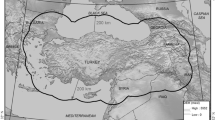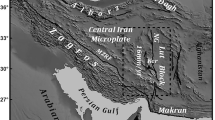Abstract
The North–South Seismic Zone is a well-known seismotectonic zone in China that frequently experiences major earthquakes. A new probabilistic seismic hazard assessment (PSHA) for this zone is required. In this study, we perform a new PSHA for the North–South Seismic Zone with new models, including a fault source model and a time-dependent seismicity model of major-earthquake seismogenic structures. We demonstrate that the seismic hazard in areas near faults calculated using the fault source model is higher than that calculated using the area model. Faults close to their expected recurrence time for major earthquakes have high seismic hazard. Areas of high seismic hazard in the North–South Seismic Zone between 2016 and 2065 are the Moxi Segment of the Xianshuihe Fault, the Anninghe Fault, and the Daliangshan Fault. High-seismic-hazard areas between 2066 and 2115 are the Luhuo and Zheduotang segments of the Xianshuihe Fault and the Anninghe Fault. The Moxi Segment of the Xianshuihe Fault has the highest seismic hazard over the next 50 years.










Similar content being viewed by others
References
Abrahamson NA, Bommer JJ (2005) Probability and uncertainty in seismic hazard analysis. Earthq Spectra 21(2):603–607
Aki K (1968) Seismic displacement near a fault. J Geophys Res 73(16):5359–5376
Bommer JJ, Scherbaum F (2008) The use and misuse of logic trees in probabilistic seismic hazard analysis. Earthq Spectra 24(4):997–1009
Bommer JJ, Scherbaum F, Bungum H et al (2005) On the use of logic trees for ground-motion prediction equations in seismic-hazard analysis. Bull Seismol Soc Am 95(2):377–389
Campbell KW, Bozorgnia Y (2008) NGA ground motion model for the geometric mean horizontal component of PGA, PGV, PGD and 5 % damped linear elastic response spectra for periods ranging from 0.01 to 10 s. Earthq Spectra 24(1):139–171
Chai CZ, Jiao DC, Liao YH et al (2003) Discovery of surface rupture zone produced by Guanguanling earthquake at the juncture of Ningxia, Inner Mongolia and Gansu Province. Seismol Geol 25(1):167–171 (in Chinese)
Chen PS, Li BK, Bai TX (1998) Prediction of peak horizontal acceleration in the light of tectonic ambient shear stress field. Chin J Geophys 41(4):502–517 (in Chinese)
Cornell CA (1968) Engineering seismic risk analysis. Bull Seismol Soc Am 58(5):1583–1606
Cornell CA, Vanmarcke EH (1969) The major influence on seismic risk. In: The fourth world conference on earthquake engineering. Santiago, Chile, pp 69–93
Delavaud E, Cotton F, Akkar S et al (2012) Toward a ground-motion logic tree for probabilistic seismic hazard assessment in Europe. J Seismol 16(3):451–473
Du PS (1994) Study on paleoseismic activity characteristics since late Quaternary and paleoearthquakes of Zemuhe Fault. Earthq Res Sichuan 1:42–52 (in Chinese)
Du Y (2012) Haiyuan fault segmentation earthquake potential analysis. Plateau Earthq Res 24(4):8–14 (in Chinese)
Du F, Wen XZ, Zhang PZ et al (2009) Interseismic deformation across the Longmenshan fault zone before the 2008 M8.0 Wenchuan earthquake. Chin J Geophys 52(11):2729–2738 (in Chinese)
Esteva L (1970) Seismic risk and seismic design decisions. In: Hansen RJ (ed) Seismic design for nuclear power plants. Massachusetts Institute of Technology Press, Cambridge, pp 142–182
Fu JD (2012) Paleoearthquake and large earhquake recurrence interval of Tazang Fault Luocha Segment of the east segment of the East Kunlun Fault. Institute of Geology, China Earthquake Administration, Beijing (in Chinese)
Gao MT (2003) New national seismic zoning map of China. Acta Seismol Sin 25(6):630–636 (in Chinese)
Gutenberg B, Richter CF (1944) Frequency of earthquakes in California. Bull Seismol Soc Am 34(4):185–188
Hebden JS, Stein S (2009) Time-dependent seismic hazard maps for the new madrid seismic zone and Charleston, South Carolina, areas. Seismol Res Lett 80(1):12–20
Hu YX (1999) Seismic safety evaluation technology tutorials. Seismological Press, Beijing (in Chinese)
Institute of Geophysics, China Earthquake Administration (2014) Concluding report, study on methodology of hazardous area recognition and seismic hazard assessment for great earthquakes. National Science and Technology Support Program: 400883690-2012BAK15B01/04 (in Chinese)
Jiang WL, Xiao ZM, Wang HZ et al (2001) Segmentation character of seismic surface ruptures of the piedmont active fault of Mt. Daqingshan, Inner Mongolia. Seismol Geol 23(1):24–34 (in Chinese)
Li TZ (1996) New progress in seismogeological research on the active Xianshuihe Fault zone. Recent Dev World Seismol 26(7):16–18 (in Chinese)
Li XJ (2013) Adjustment of seismic ground motion parameters considering site effects in seismic zonation map. Chin J Geotech Eng 35(Suppl 2):21–29 (in Chinese)
Li HJ, Sun HW (1973) The statistical regionization of the North-South Seismic Belt in Central China. Sci Geol Sin 2:162–166 (in Chinese)
Li Y, Zhou RJ, Densmore AL et al (2006) Geomorphic evidence for the late Cenozoic strike-slipping and thrusting in Longmen Mountain at the eastern margin of the Tibetan Plateau. Quat Sci 26(1):40–51 (in Chinese)
Li CS, Yang JS, Zheng Y et al (2013) Research on space-time distribution characteristics of strong earthquakes in the north’south seismic belt and its adjacent area. Seismol Geomagn Obs Res 34(5):24–31 (in Chinese)
Li CL, Xu WJ, Wu J et al (2015) Time-dependent probabilistic seismic hazard analysis methods and its applications based on characteristic earthquake models. Acta Seismol Sin 37(6):1024–1036 (in Chinese)
Long F, Jiang CS, Feng JG et al (2012) Quantitative seismicity analysis for the risk of historical large earthquake rupture zones: applied to the mid-north segment of the South-North Seismic Belt. Earthquake 32(3):98–108 (in Chinese)
Lu P, Yuan YF, Yuan HK et al (2012) Probabilistic estimate of strong earthquake risk in the Anninghe-Zemuhe tectonic zone. Earthquake 32(4):62–72 (in Chinese)
Matthews MV, Ellsworth WL, Reasenberg PA (2002) A Brownian model for recurrent earthquakes. Bull Seismol Soc Am 92(6):2233–2250
McGuire RK (1976) Fortran computer program for seismic risk analysis. USGS Open-File Report, pp 76–67
Mei XP, Shao ZG, Zhang LP et al (2012) Study on potential earthquake risk of unbroken active faults in the northern segment of the North-South seismic zone. Acta Seismol Sin 34(4):509–525 (in Chinese)
Min W, Chai CZ, Wang P et al (1993) The study on the paleoearthquakes on the eastern piedmont fault of the Luoshan Mountain in Holocene. Plateau Earthq Res 5(4):97–102 (in Chinese)
Nishenko SP, Buland R (1987) A generic recurrence interval distribution for earthquake forecasting. Bull Seismol Soc Am 77(4):1382–1399
Pan H, Gao MT, Xie FR (2013) The earthquake activity model and seismicity parameters in the new seismic hazard map of China. Technol Earthq Disaster Prev 8(1):11–23 (in Chinese)
Ran YK, Wang JB, You HC et al (1990) Fracture traces by historic earthquakes in Shangguan-Panqu zone of Dali area, Yunnan Province. Seismol Geol 12(3):272–274 (in Chinese)
Ran YK, Zhang PZ, Chen LC (2003) Research on the completeness of paleoseismic activity history since late Quaternary along the Daqingshan Piedmont Fault in Hetao Depression Zone, North China. Earth Sci Front 10(Suppl):207–216 (in Chinese)
Reid HF (1911) The elastic rebound theory of earthquakes. Bull Dep Geol Univ Calif 6:412–444
Ren JJ (2013) Late Quaternary activity of the Longriba Fault Zone and its kinematic relations with adjacent faults. Institute of Geology, China Earthquake Administration, Beijing (in Chinese)
Ren XM, Zhao WM, Chai CZ et al (2002) Estimation of recurrent interval of strong earthquakes in NS earthquake belt. Inland Earthq 16(1):69–75 (in Chinese)
Schnabel PB, Seed HB (1973) Accelerations in rock for earthquakes in the western United States. Bull Seismol Soc Am 63(2):501–516
Shao YX, Yuan DY, Wang AG (2011) The segmentation of rupture and estimate of earthquake risk along the north margin of western Qinling Fault Zone. Seismol Geol 33(1):79–90 (in Chinese)
Teng RZ, Jin YQ, Li XH et al (1994) Recent activity characteristics of the fault zone at northern edge of Western Qinling MT. Northwest Seismol J 16(2):85–90 (in Chinese)
Toro GR (1995) Probabilistic seismic hazard analysis: a review of the state of the art. In: Proceedings of the fifth international conference on seismic zonation, vol 3, pp 1829–1857
Wang YP (1988) Active fault systems around erdos block. Seismological Press, Beijing (in Chinese)
Wang XM, Pei XY (1988) Some new points of view on the 1786 earthquake (M = 7 3/4) occurring in the area between Kangding and Moxi, Luding, Sichuan Province. Earthq Res China 4(1):108–115 (in Chinese)
Wen XZ (1995) Quantitative estimates of seismic potential on active faults. Seismological Press, Beijing, pp 1–150 (in Chinese)
Wensnousky SG (1986) Earthquake Quaternary faults, and seismic hazard in California. J Geophys Res 91(B12):12587–12631
Wu YQ, Jiang ZS, Yang GH et al (2012) Deformation characteristics of north section of North-South Seismic Zone in recent period. Geomat Inf Sci Wuhan Univ 37(9):1045–1048 (in Chinese)
Xing CQ, Wang YB (1991) Zhuozishan Fault Zone and its neoactive characteristics. Northwest Seismol J 13(3):86–88 (in Chinese)
Xu GY, Gao MT (2007) Potential rupture surface model and its application on probabilistic seismic hazard analysis. Acta Seismol Sin 29(3):285–294 (in Chinese)
Xu XW, Chen GH, Yu GH et al (2010) Reevaluation of surface rupture parameters of the 5·12 Wenchuan earthquake and its tectonic implication for Tibetan uplift. Chin J Geophys 53(10):2321–2336 (in Chinese)
Yang XP, Ran YK, Hu B et al (2002) Paleoseismic activity on Wujiahe segment of Serteng Piedmont Fault, Inner Mongolia. Acta Seismol Sin 25(1):62–71 (in Chinese)
Yi GX, Wen XZ (2000) Application of the time-and-magnitude predictable model to seismic hazard assessment in segmentation of the north-south seismic belt. Earthquake 20(1):71–79 (in Chinese)
Yu YX, Li SY, Xiao L (2013) Development of ground motion attenuation relations for the new seismic hazard map of China. Technol Earthq Disaster Prev 8(1):24–33 (in Chinese)
Zhang JL, Ren JW, Fu JD et al (2012) Earthquake rupture features and tectonic significance of the Tazang fault in the eastern part of the East Kunlun Fault Zones. Earthquake 32(1):1–16 (in Chinese)
Zhou BG, Chen GX, Gao ZW et al (2013) The technical highlights in identifying the potential seismic sources for the update of national seismic zoning map of China. Technol Earthq Disaster Prev 8(2):113–124 (in Chinese)
Acknowledgments
The time-independent seismic hazard model was obtained from the Compiling Committee of the Seismic Zoning Map in China. We thank them for providing the area source model, seismicity model, GMPE model, and site condition model data. We are also grateful to the research group of Study on methodology of hazardous area recognition and seismic hazard assessment for great earthquakes of the Institute of Geophysics, China Earthquake Administration, for providing the parameters of major-earthquake seismogenic structures in the North–South Seismic Zone. The study was sponsored by Earthquake Industry Specific Fund (201408014).
Author information
Authors and Affiliations
Corresponding author
Additional information
Sponsored by: Earthquake Industry Specific Fund (201408014).
Rights and permissions
About this article
Cite this article
Li, C., Xu, W., Wu, J. et al. Using new models to assess probabilistic seismic hazard of the North–South Seismic Zone in China. Nat Hazards 82, 659–681 (2016). https://doi.org/10.1007/s11069-016-2212-5
Received:
Accepted:
Published:
Issue Date:
DOI: https://doi.org/10.1007/s11069-016-2212-5




